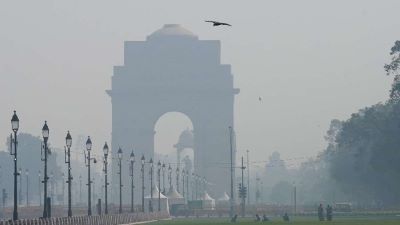Context:
The escalating issue of air pollution in India, particularly in the National Capital Region (NCR), has necessitated immediate attention and decisive actions, necessitating tough choices and decisions at both societal and governmental levels.Recently,, the central government issued a directive to halt non-essential construction activities and the operation of BS-III petrol and BS-IV diesel four-wheelers in Delhi-NCR, citing the escalating air pollution crisis.
The intricate nature of environmental problems, such as climate change and air pollution, necessitates a delicate balance between developmental goals and environmental preservation. In this complex landscape, the responsibility of making informed trade-offs falls on the shoulders of key stakeholders, including scientists, government authorities, and the general public.
Status of air pollution in NCR
The Commission for Air Quality Management, a regulatory body tasked with developing and implementing air pollution mitigation plans for the area, observed a notable increase in Delhi's Air Quality Index (AQI) at 10 am and 11 am, reaching 458 and 457, respectively. This rise was attributed to unfavorable weather conditions and sources of local pollution.
In preparation for an extended period of significantly poor air quality, the committee has opted to enforce Stage-III restrictions of the GRAP (Graded Response Action Plan) promptly. This proactive measure aims to curb any further degradation in air quality.
|
About GRAP ● The Graded Response Action Plan (GRAP) is the Centre's air pollution control plan implemented in the region during the winter season. ● GRAP, or the Graded Response Action Plan, constitutes a set of emergency measures activated to mitigate the further deterioration of air quality in the Delhi-NCR region once it crosses a specified threshold. The Supreme Court approved GRAP in 2016 following its order in the case of M. C. Mehta vs. Union of India (2016), and it was officially notified in 2017. ● Since 2021, the implementation of GRAP has been overseen by the Commission for Air Quality Management (CAQM). Before this, until the year 2020, the Environment Pollution (Prevention & Control) Authority (EPCA), appointed by the Supreme Court, was responsible for directing states to enforce GRAP measures. ● In 2020, the EPCA was dissolved, and the CAQM took over its role. The CAQM relies on air quality and meteorological forecasts provided by the Indian Institute of Tropical Meteorology (IITM) and the India Meteorological Department (IMD). ● It categorizes actions into four stages: Stage I - 'Poor' (AQI 201-300); Stage II - 'Very Poor' (AQI 301-400); Stage III - 'Severe' (AQI 401-450); and Stage IV - 'Severe Plus' (AQI>450). |
The Role of Stakeholders:
● Scientists and Academia:
In the pursuit of understanding and mitigating air pollution, scientists, especially those in atmospheric sciences and health sectors, play a crucial role. Their responsibility lies in generating comprehensive evidence that can inform policy decisions. While science may have some gaps, the role of academicians is not to make trade-offs but to present evidence that allows informed decision-making.
● Activists and Public Engagement:
Activists have a valuable role in shaping the discourse, often advocating for pro-environment trade-offs. However, it is essential to acknowledge that there is no single right trade-off. Open dialogue is crucial, and a hard stance may hinder the discussion. While courts may not be the ideal platform for these discussions, they can ensure the availability of forums for debates. The political class, as representatives of the people, emerges as a logical choice, although their current inability to address the issue effectively is evident.
Understanding Political Decision-Making:
● Lessons from Past Initiatives:
Examining past initiatives, such as the Bus Rapid Transport (BRT) corridor and the odd-even experiment in Delhi, provides insights into the intersection of air pollution and political decision-making. Despite the success of the BRT corridor in achieving its intended objectives, it was dismantled due to political capitulation in the face of resistance from the car-using middle-class. The odd-even experiment, implemented during a public health emergency, showcased the contextual nature of its impact, but its political acceptability persisted despite debates on effectiveness.
● Political Narratives and Public Perception:
Political decisions often rely on narratives that shape public perception. The installation of smog towers, despite questions about their effectiveness, highlights the importance politicians place on creating a perception of sensitivity to public concerns. The challenge in addressing issues like crop burning lies in finding win-win solutions and convincing all stakeholders. This demands a comprehensive package of technical, regulatory, fiscal, and informational interventions, defined clearly and marketed well to ensure the participation of all stakeholders.
Public Involvement and Incentivization:
● Need for Incremental Gains:
While incremental gains in the fight against pollution are being made, the pace is insufficient to counter the increasing pollution levels. The public plays a pivotal role in making it politically expedient to address the issue effectively. However, there is a gap between the readiness for short-term inconveniences, like odd-even measures, and acceptance of hard decisions by the middle-class.
● Setting the Right Political Narrative:
Progress in the fight against pollution requires a strategic interplay between politicians and the public. Politicians need to incentivize people through appropriate public policies, creating a circular logic where citizens signal their readiness for compromise. This interaction can potentially lead to a tipping point when the middle class is willing to embrace significant changes, such as increased use of public transport and cleaner vehicles.
Conclusion:
Air pollution crisis in India, especially in NCR, demands urgent and comprehensive action. The intricate interplay between scientists, activists, and the political class is crucial in shaping informed decisions that strike a balance between development and environmental preservation. Learning from past initiatives, understanding political narratives, and actively involving the public are essential components of effective decision-making. Achieving a tipping point in the fight against air pollution requires a coordinated effort, with politicians leading the dance by incentivizing the public through thoughtful policies. As the challenges persist, a collective commitment from all stakeholders is necessary to move beyond the current impasse and ensure a sustainable and breathable future for all.
|
Probable Questions for UPSC Mains Exam
|
Source – Indian Express








